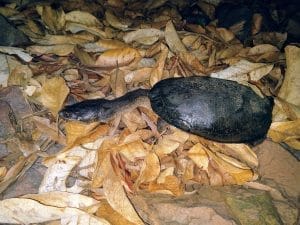Chelodina parkeri (Parker’s Snake-necked Turtle)
Home > Turtle Database > Chelodina parkeri (Parker’s Snake-necked Turtle)

Chelodina Parkeri is a unique species of snake-necked turtle found in Papua New Guinea. Known for its elongated neck and distinctive appearance, this turtle is part of the Chelidae family, which includes several other snake-necked turtles.
Native To These Regions
Northern Territory (Australia)Native Turtle Species Map – Find Turtles by Region
Scientific Classification
- Kingdom: Animalia
- Phylum: Chordata
- Class: Reptilia
- Order: Testudines
- Family: Chelidae
- Genus: Chelodina
- Species: C. parkari
Common Names
- Parker’s Snake-necked Turtle
This Hilarious Turtle Book Might Know Your Pet Better Than You Do
Let’s be real—most turtle care guides feel like reading a textbook written by a sleep-deprived zookeeper.
This one’s not that.
Told from the snarky point of view of a grumpy, judgmental turtle, 21 Turtle Truths You’ll Never Read in a Care Guide is packed with sarcasm, sass, and surprisingly useful insights.
And hey—you don’t have to commit to the whole thing just yet.
Grab 2 free truths from the ebook and get a taste of what your turtle really thinks about your setup, your food choices, and that weird plastic palm tree.
It’s funny, it’s honest, and if you’ve ever owned a turtle who glares at you like you’re the problem—you’ll feel seen.
Identification
Description:
Chelodina parkari is characterized by its long neck, which can be almost as long as its shell. The carapace is typically dark brown or black, while the plastron is lighter, often yellowish. The turtle’s head is elongated, and its limbs are sturdy with webbed feet.
Sexual Dimorphism:
Males are generally smaller than females and have longer, thicker tails. Females tend to have a broader carapace.
Check more turtles from the Chelodina genus
Native Origin and Distribution
Geographical Range:
Chelodina parkari is native to Papua New Guinea, specifically found in the southern lowlands and river systems.
Preferred Habitat
This species prefers slow-moving freshwater habitats such as swamps, marshes, and rivers. They are often found in areas with abundant aquatic vegetation.
Behavior
Feeding Habits:
Chelodina parkari is carnivorous, feeding on fish, amphibians, and invertebrates. They use their long necks to strike at prey quickly.
Predators:
Predators of this turtle include large fish, birds, and occasionally mammals. Hatchlings and juveniles are particularly vulnerable to predation.
Reproduction
Breeding Season:
The breeding season typically occurs during the wet season when water levels are high.
Reproductive Method:
Females lay eggs in nests dug into sandy or muddy banks. Clutch sizes can vary, and incubation periods depend on environmental conditions.
Conservation
Extinction Status:
Chelodina parkari is currently not listed as endangered, but it faces threats that could impact its population.
Threats:
Habitat destruction, pollution, and collection for the pet trade are significant threats to this species.
Conservation Measures:
Conservation efforts include habitat protection, regulating the pet trade, and research on population dynamics and ecology.
Economic Importance
Chelodina parkari is occasionally collected for the pet trade, which provides economic benefits but also poses a threat to wild populations.
Interesting Facts
- Chelodina parkari can extend its neck to almost the same length as its shell, which helps it catch prey efficiently.
- This species is part of the Chelidae family, known for their unique long-necked turtles found primarily in Australia and New Guinea.

About Author
Muntaseer Rahman started keeping pet turtles back in 2013. He also owns the largest Turtle & Tortoise Facebook community in Bangladesh. These days he is mostly active on Facebook.














